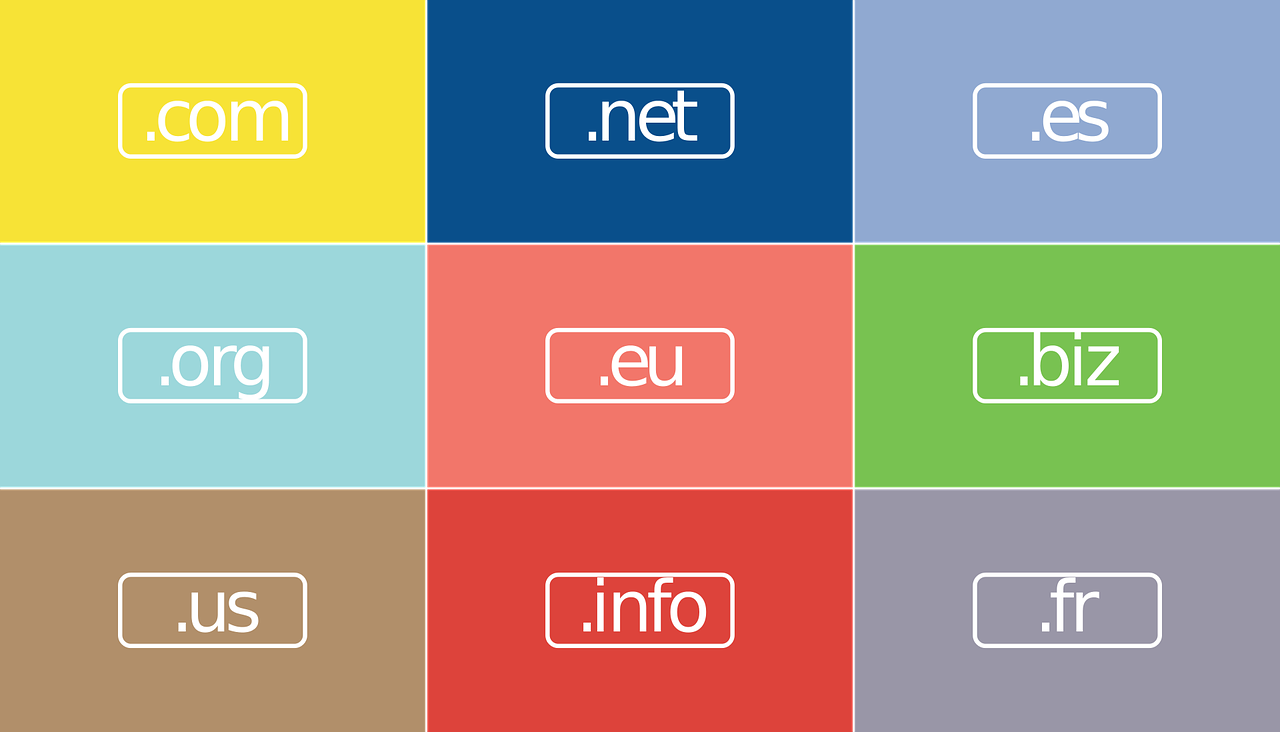Blog
Domain Name Registration Renewal, and How to Choose the Best Extensions for Startups and E-Commerce

Domain Name Registration, Renewal, and How to Choose the Best Extensions for Startups and E-Commerce
You are anxious to establish an online presence for your brand, but you are unable to complete one important step: selecting the appropriate domain name for your company. Your domain name represents the external appearance of your store; therefore, choosing it can often feel challenging. For viewers, it might be either welcoming or uncomfortable.
We’ll make your decision-making process easier in this article by going over and assisting you with the most important aspects to take into account when selecting a domain name that accurately represents your company. Also, you’ll learn some useful tips to consider before or when registering your desired domain name and extension for personal blogs, business websites, and non-profit websites.
How to Register a Domain Name (The Easiest Way)
Registering a domain name involves getting the desired name from an agency known as ICANN via domain name registrars. For example, if you select a domain name such as “johndoe.com,” you must visit a registrar and pay a registration charge ranging from approximately 10 to 20 USD annually.
This will confer upon you the rights to the domain name for one year. It is advisable to renew it every year for the same amount.
During domain registration, you will be required to provide your information, such as
- Complete name
- Email address
- Mobile number
- Residential address
Below are several methods to effectively register your preferred domain name.
Step 1. Search for your desired domain name
Enter your preferred domain name in the search field for domain names. The system will automatically add it to your cart if it is available. However, if it is not, the site will offer optimal alternatives for your selection.
Choose how long you want to register a domain by navigating through the items in your cart.
Domain Privacy Protection will be immediately included in your cart. You may retain this in your cart to safeguard your domain’s information from public access. This feature can easily be removed if desired.
Step 2. Get domain add-ons
To safeguard your domain from online attacks, use this time to implement crucial security measures like SSL Certificates and Domain Expiration Protection.
Put more necessary productivity products in your shopping, such as the AI website builder and Google Workspace email.
Step 3. Proceed to billing
To register your domain, make sure you fill out all the required fields. To guarantee a successful domain registration, try verifying your billing details, including your name, payment method, and login credentials.
Step 4: Confirm your purchase
Check your email last. An email confirmation will be sent to the email address you registered with after your purchase. Additionally, follow to the guidelines provided in the email confirmation.
A simple tip: To safeguard your brand and avoid losing traffic, think about registering various domain variants under your account, such as abbreviated and misspelled versions. The majority of successful websites employ the common tactic of linking several domains to the same webpage.
Facebook, for example, has two primary domains: fb.com and facebook.com. In this manner, it diverts users to the Facebook website regardless of the method they input into their web browser.
What is Domain Renewal?
The process of renewing a domain name with a domain registrar is known as “renewal.” Usually, this involves offering updated contact details and paying a renewal cost. A domain name should be renewed before it expires to avoid losing it. The duration of a domain renewal can range from one to five years, and the cost will change based on the domain extension (e.g.,.com,.net,.org). Before registering a chosen domain name, it is crucial to learn about the renewal procedure and associated costs.
Maintaining a website requires an active domain name. If a domain has expired, users will not be able to view its content. Additionally, when a domain name expires, it may be made accessible to the public or sold at auction to the highest bidder. Losing a domain name due to its expiration can significantly impact an online business.
How to renew an active domain name?
It’s crucial to renew your domain name before it expires in order to prevent losing access to services like your email or website. With the majority of domain registration providers, renewing a domain is simple.
Here’s how to do it:
- Go to Billing → Subscriptions after logging onto your Domain Name provider account.
- Locate the domain that has to be renewed. Click on the arrow to open the Subscription details window.
- Decide on the payment method and registration period.
- Verify the purchase by making sure the expiration date has been changed on the Domains page.
Alternatively, you can use the Domains page to renew your domain:
- Navigate to Domains → the Domain portfolio page.
- To renew a domain, click Renew next to it.
- The Domain Overview page is another way to renew a domain. Just choose “Renew now” next to the date of expiration.
Note that some TLDs only permit renewals that occur within 28 days of the original term. This restriction can be the cause if you are unable to locate the renewal button.
What Are Domain Extensions?

The final portion of a web address that comes after the last dot is called a domain extension, or top-level domain (TLD). The top tier of the Domain Name System (DNS) hierarchy is a TLD.
In the 1980s, domain extensions were originally used to assist organize the fast expanding number of websites on the fledgling internet. In the beginning, there were only a handful of what are known as generic top-level domains (gTLDs), including .com, .net, .org, .edu, and .gov domains.
Introduction of New TLDs
New kinds of TLDs were progressively added as the internet grew.
Among these were country-code TLDs (ccTLDs), two-letter domains that stand for certain nations or areas, like.us for the US and.uk for the UK. Eventually, new generic TLDs (gTLDs) such as.biz,.info, and.name were also introduced.
The 4 Categories of TLDs
Hundreds of TLD possibilities are available, but they are not all created equal. Although they have a wide variety of flavors, the majority can be divided into four groups:
1. Generic domains: These are just what they sound like — generic extensions that anyone can register, regardless of what kind of website they have. A few well-known examples are.blog,.shop, and.news.
2. Industry-specific domains: These specialized domains are available to companies and organizations operating in specific industries. In a sense, you must be a confirmed member of the club. Examples include.bank for financial institutions and.law for legal procedures.
3. Geographic domains: These extensions with a geographic focus are only available to companies or people who are headquartered in a certain area. Consider.nyc for businesses situated in New York City or.berlin for businesses based in Berlin, Germany.
4. Brand domains: These unique TLDs are owned and run by specific businesses or brands. Unfortunately, you can’t have one — unless you are Google or Apple, in which case, .google and .apple are all yours. If they are fortunate enough to have one, brands are free to establish their own registration standards.
Although fewer in number than the original heritage TLDs, the advent of these new TLDs, or nTLDs for short, has contributed to the development of a more structured and user-friendly internet. People can now more easily find domain names they like instead of ones they have to use.
Popular gTLDs for ecommerce businesses
gTLDs, like.shop,.store, and.online, have grown in popularity recently among e-commerce companies looking to establish a more memorable and focused domain name. In e-commerce, some common domain name extensions are:
- .com is the most widely recognized and trusted gTLD, and is synonymous with the internet itself. It is an excellent option for companies looking to have a worldwide web presence.
- .net is frequently used by companies that provide networking or technology-related goods and services because it implies an internet connection.
- .org is commonly used by non-profit groups, but it can also be used by companies that wish to communicate a feeling of community involvement or social responsibility.
7 Things to consider before you choose a domain or an extension for your website

You can choose whatever name you like when you register a domain, but the name you choose will have a significant impact on your website or the future of your company. You can also trademark the extension component in addition to your domain name.
Therefore, when you register a domain name and extension for your website, you should be aware of the following guidelines or checklists:
- Select a domain name that has the potential to serve as your brand name, if needed. Avoid purchasing a domain that includes numbers if your brand lacks numerical representation. From the user’s viewpoint, this creates a disconnect in brand alignment.
- For your business needs, secure domains with a range of extensions like .com, .net, .info, .biz, and more. It’s best to choose a .com. Remember to select extensions that align with your business.
- Non-profit organizations can choose the .org extension.
- Verify that the domain name you wish to register is free from trademark or copyright claims.
- Discover a concise domain name that’s simple to spell, featuring either one phrase or a maximum of two phrases. A shorter domain name is more memorable, easier to type, simpler to say, and more accessible for sharing, making it stand out on social media and in search results.
- If your website caters to local customers, consider purchasing a domain that includes your country’s suffix. A local website in Nigeria might choose domains like .com.ng or .ng, among others.
- If your domain name doesn’t reflect your brand, make sure to incorporate specific keywords that accurately describe your business, such as farmerseducate.com. It naturally enhances your search engine ranking, boosting traffic, while also resonating more effectively with your potential customers.
Future-proofing your domain extension strategy
Selecting the perfect domain extension for your business is an essential choice, as it can significantly influence your online visibility and brand identity.
Your domain extension’s scalability and flexibility are crucial given the abundance of online communities, customer networks, web-based services, and much more.
Evaluate how well your domain extension can adapt and grow by reflecting on your business’s long-term goals and the role your online presence will play in achieving them.
Additionally, evaluate the technical strengths and weaknesses of your selected domain extension, including its capacity for subdomains and email hosting options.
Conclusion
A crucial step that can affect your brand image, search engine rankings, and client trust is choosing the appropriate domain extension for your e-commerce company.
Choosing the perfect domain extension can enhance your SEO, boost your professional image, and assist your customers in finding your business online with ease.
With a multitude of options at your fingertips, pinpointing the ideal domain extension for your business can be quite a challenge.
Take into account elements like the accessibility and registration costs, the significance of the extension to your specific niche, and the flexibility and growth potential of your selected extension.
Ensure you secure alternative domain extensions to safeguard your brand and stay updated on the latest trends and developments in domain extensions.
Ultimately, selecting an ideal domain extension can significantly impact your e-commerce business. Take a moment to assess your choices, consider the advantages and disadvantages, and arrive at a well-informed decision. Your website’s success may depend on it.
Share
15 Minutes Free Discovery Call
How Zrafted Can Help Businesses?
- Contact Centre Solutions
- Managed IT Services
- Digital Marketing
- Business Process Outsourcing
- Virtual Assistance
- E-Commerce

